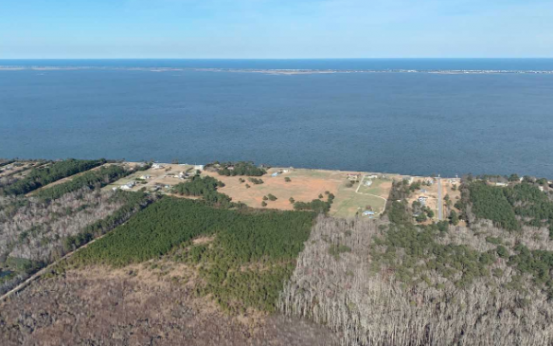The Mid Currituck Bridge – Pros and Cons
The Mid Currituck Bridge is now closer to becoming a reality than it ever has in the past. The Record of Decision (ROD) that was issued by NCDOT in March with the explicit approval of the Federal Highway Administration (FHWA) is the farthest toward actually building the bridge the project has ever gotten.

Relying heavily on the Environmental Impact Statement that must accompany any highway project, the ROD summarizes the steps that were taken to bring the project to its completion. It is the final paperwork step before bids are let and the project can begin.
Depending on your point of view the Mid Currituck Bridge has either been in the planning stages 41, 29 or 24 years.
A Brief History
A bridge connecting the Currituck Banks with the mainland was first proposed in a 1978 planning document as part of a planning exercise for the UNC School of Government. The Currituck Board of Commissioners endorsed the plan but no action was ever taken on it
A Mid Currituck Bridge first appeared as part of NCDOT’s Transportation Improvement Plan (TIP) in 1990.
The ROD documentation places the beginning of the project in 1995 when the FWHA published a Notice of Intent to prepare an environmental impact Statement.
An Environmental impact Statement was published in 2003, but was never finalized.
The cost of the project was always a problem, and when the NC Turnpike Authority was formed in 2007, local governments and groups supporting the bridge lobbied to have it included as a toll road.
Initial funding plans called for the bridge to be funded through a private/public partnership, but when there was a change in political philosophy in the State legislature, the plans were withdrawn.
The bridge will still be a toll road. Funding is provided through state and federal funds and a number of federal highway bonds.
The estimated cost of the project is $491 million. If all goes according to the NCDOT timeline, construction will begin n the spring of 2021. No ribbon cutting date has been given, but typically projects of this complexity take two years to complete.
Why Build the Bridge
Any project of this size takes substantial justification and the ROD provides considerable information outlining the the reasons the reasons NCDOT and FHWA feel the bridge is needed.
Project managers looked at three factors in determining the best alternative: evacuation times, traffic flow and travel times.

The alternative that was selected, connecting Aydlett on the mainland with Corolla, would have the least impact on homes and businesses with the greatest improvement in meeting the purpose and need of the project according to the ROD.
“The Selected Alternative will: substantially improve traffic flow on the project area’s thoroughfares (US 158 and NC 12); substantially reduce travel time for persons traveling between the Currituck County mainland and the Currituck County Outer Banks; and reduce substantially evacuation times from the Outer Banks for residents and visitors who use US 158 and NC 168 as an evacuation route,” the study’s authors noted in.
What are the Concerns
From the outset two issues have floated to the top: the environment and cost.
Much of the environmental concerns center on Maple Swamp, a fragile mixture of marsh, shallow ponds, and forest that parallels Currituck Sound. Extending north from Poplar Branch to Water Lily, it is about ten miles long.
The Mid Currituck Bridge is almost exactly at the halfway point of the swamp.
The bridge that has been approved includes considerable environmental improvements over the original design. Perhaps most significantly, Maple Swamp will be bridged. The original plans called for a road to cut through the swamp.
Other mitigation steps are being taken, especially during construction and in storm water runnoff.
There is little that can be done about the cost. The hope is that, with a projected use of 2.8 million vehicles per year, toll collections will be sufficient to pay off bonds and fund maintenance.
The Lawsuit
The Southern Environmental Law Center (SELC) has filed suit in Federal District Court to stop the project.
According to the SELC the bridge would:
- further beachfront development in an area
already vulnerable to erosion, hurricanes, rising sea levels, and other
threats likely to become more severe as a result of global climate change;
- damage to water quality and aquatic habitat in the Currituck estuary; and
- thousands more vehicles and traffic on the beaches of the Currituck National Wildlife Refuge. (SELC website)
Legally the suit takes issue with the revised Environmental Impact Statement alleging there was inadequate public input. The SELC did participate in the revised Impact statement.

Predicting the outcome of any lawsuit is chancy, but unlike the court battles over the Bonner Bridge replacement the SELC fought, it would appear as though NCDOT and the FHWA operated within the Environmental Impact Statement guidelines. Specifically, the FHWA points to improved environmental impacts in the final plan and the federal guidelines governing that.
“The regulations also state that a supplemental EIS is not necessary where changes result in a lessening of adverse environmental impacts,” is written in the ROD.
What Happens Next
Although the SELC is filing on behalf of some local residents and groups, the fact is the Mid Currituck Bridge enjoys overwhelming support from local residents and government. Whether that will influence the court is difficult to say, but probably doubtful.
There will be some form of hearing pertaining to the lawsuit. Under any circumstances, court filings will slow the process down and the 2021 start date for construction may be optimistic.
Nonetheless, a bridge crossing Currituck Sound is closer to reality than it has ever been.
